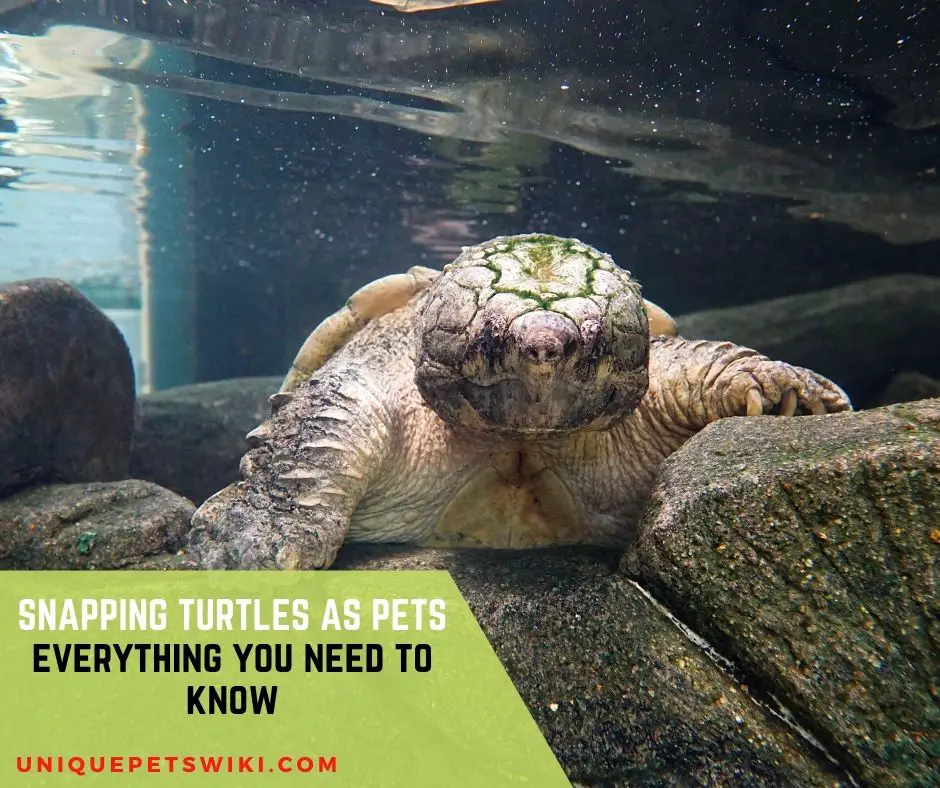The snapping turtles which are the biggest species of turtles in Canada can easily be identified by their extremely large total body size, bulky head, extremely long/flexible neck, nearly flat carapace, small plastron, short pointed snout, and hooked beak.
Geographically, they are only found in North America spanning across the Rocky Mountains to the Eastern part of Florida and Nova Scotia in Canada down to Northern Mexico and central Texas.
In these regions, they inhabit a wide variety of habitats. Essentially any prominent body of water, whether big or small.
Being aquatic, they seem to prefer quiet ponds, lakes, and slow-moving streams with a muddy bottom and bountiful vegetation. During the breeding season, adult female snapping turtles lay a large clutch of eggs.
In a single birth, adult females can lay over 30 eggs per nest in a year. Of all the eggs laid by the adult female throughout its entire reproductive life, only a few (about one or two) survived to become reproductive adults.
The rate of survival is higher in adults than in hatchlings and juveniles. This is because as hatchlings, they are prey to several large animals and barely make it to adulthood. These species of turtles take a longer time to get to maturity.
To get to maturity it can take them between 17 to 20 years. These animals are omnivorous, consuming both plants and animals. Hatchlings and juvenile snapping turtles consume more animal matter than plants to aid them in growth.
Snapping turtles are important scavengers and they contribute greatly to the ecosystem by eating dead animals. Adult snapping turtles consume more vegetation than animals, including algae.
These animals are gentle to a large extent and do not attack people. Hence, if you’ve been wondering what species of pet to get, snapping turtles can be a great addition to your collection of pets.
With all these qualities listed above, it’s impossible not to fall in love with snapping turtles.
Contents
Snapping Turtle: Species Overview
There are two different subspecies of aquatic turtles called the snapping turtle. These two species of turtles have many features and characteristics in common which is why they are grouped as one family/species called “the snapping turtles”.
They are so-called snapping turtles because of their unique ‘snapping’ behavior while eating and when attacking prey or predator. The two subspecies are “the common snapping turtle and alligator snapping turtle”.
Common Names
Their common names as stated earlier are ‘the alligator and the common snapping turtle. Scientifically, these two subspecies of snapping turtles go by the name ‘macrochelys temminckii’ and ‘Chelydra serpentina and from the same family ‘Chelydridae’.
But they both belong to a different genus of Macrochelys and Chelydra serpentina respectively.
The Chelydra serpentina got its name from the fact that its neck can twist or turn in any direction and can stretch to about 12 inches just like in snakes.
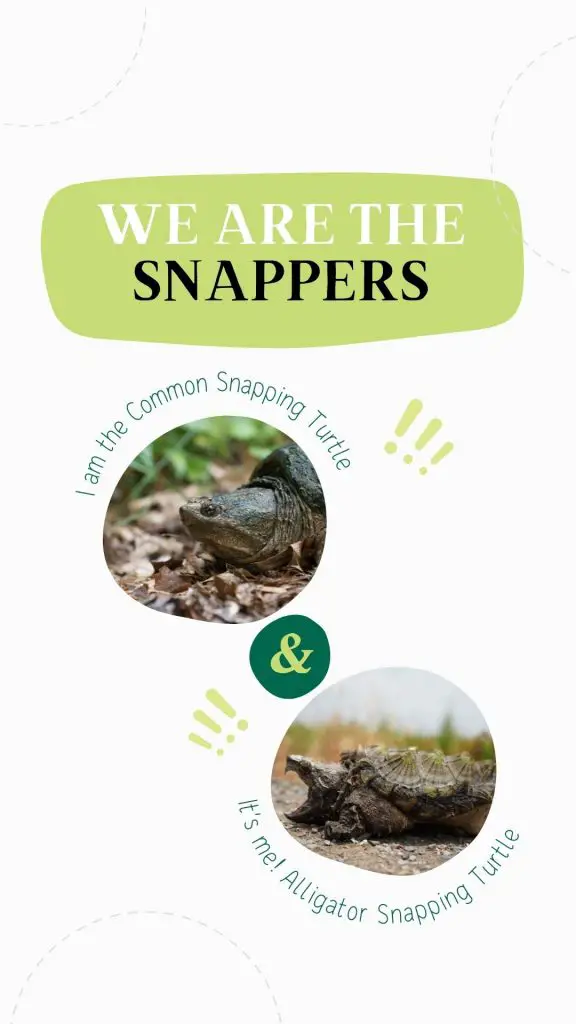
Adult Size
Snapping turtles are big in size but not as compared to the largeness of land tortoises. They weigh heavier but have a small carapace and plastron.
A large part of their body is exposed as their back isn’t large enough to cover their entire body. On average, the common snapping turtle weighs between 16kg – 136kg and their carapace measure between 8 inches – 18 inches.
On the other hand, the Alligator snapping turtles measure longer and weigh heavier. They are seen as the largest species of freshwater turtle. They typically weigh between 155 -175 pounds.
Life Expectancy
Both the common and alligator snapping turtles are long-lived pets. In the wild, they have a lifespan of about 30 years or less. This is because as hatchlings they’re vulnerable to attack by other animals.
Only a few hatchlings usually make it to adulthood. But once they get old, they’re vulnerable to attack by only a few natural predators.
However, with the absence of predators coupled with good care in captivity, they can live for up to 50 years and above.
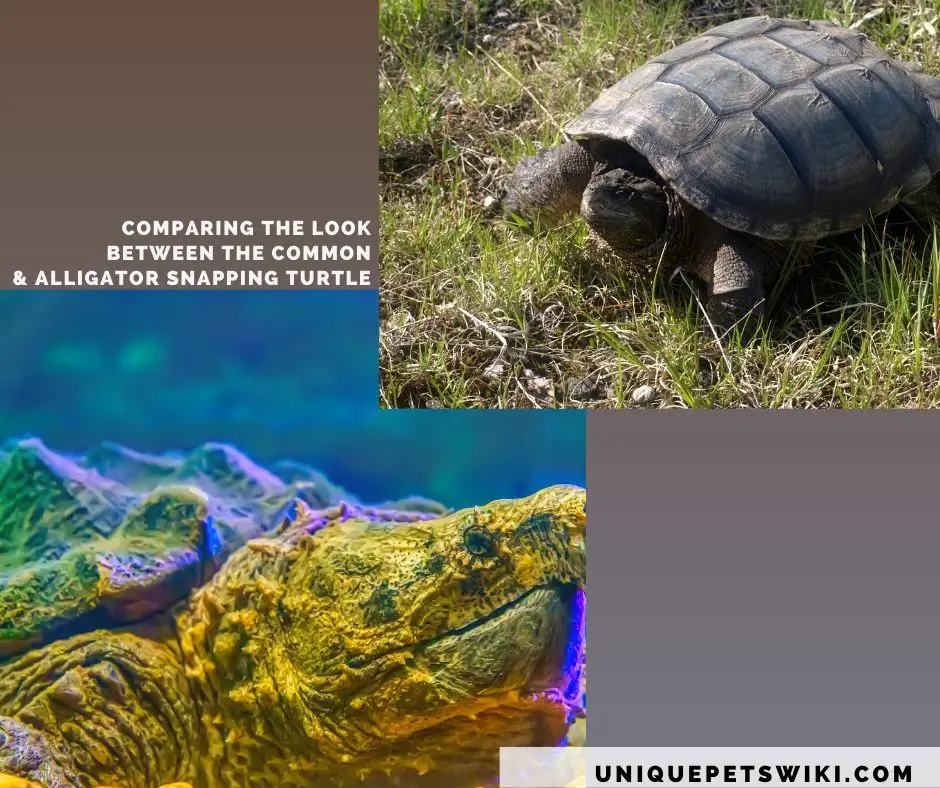
Can You Keep A Snapping Turtle As A Pet?
Yes, you can. For over 50 years now, snapping turtles have been owned as companion pets in the US, Canada, UK, and other parts of the world.
Currently, because of the advancement and encouragement of captive breeding, snapping turtles can be found almost in every part of the world as pets.
These animals are extremely calm and do not pose a threat to human safety. Going by their unique personality and calm disposition, it’s unlikely as a herpetologist not to like and desire to keep snapping turtles.
To better understand these animals, let’s delve into their personality in detail.
Behavior And Temperament
Snapping turtles are calm and easy to manage as pets. They are not always aggressive except when triggered to.
Factors that’ll trigger aggression in snapping turtles are stress and threat. They are generally calm when in the water but will act like angry monsters when on land.
One reason they act aggressively on land is because they feel insecure by any approaching animal since they don’t have a large scale that they can pull themselves in for protection.
Hence, to defend themselves outside their natural habitat, they need to be aggressive. Keeping this in mind, you must ensure you eradicate everything that’ll cause stress to your pets. This will help reduce the risk of potential bites.
Besides being aggressive when on land, snapping turtles lack social interaction between members of the same species, especially among males.
Typically, only a single snapping turtle inhabits a particular section of a stream or lake. Other snapping turtles may also live in the same body of water but not in close proximity to one another.
Even with this, how many snapping turtles can be found in one body of water depends on the availability of food in the habitat.
Throughout the history of snapping turtles, the only time snapping turtles are seen to interact with one another is during the breeding season and this interaction is usually between the male and females.
Interaction between the males often involves fighting. One more unique characteristic of snapping turtles is their method of hunting for prey.
In the wild, these animals lay in ambush to attack their prey. This is to say that if you do not provide enough accessories in their enclosure that can encourage burrowing and hiding, this also can cause environmental stress.
Danger
Snapping turtles are not dangerous animals. They do not pose any danger even to a family with kids. But they might bite you if they see you as a threat. That notwithstanding, the bites from them isn’t poisonous.

Aggressive
As stated earlier, snapping turtles will not act aggressively unless the situation calls for it. They are naturally calm and shy. If they’re faced with danger when in the water, the best they do is to run or burrow in the mud.
Hardly will they fight back. But when they’re on land, they tend to be aggressive to any intruder in self-defense. Therefore, you’re likely to encounter the aggressive part of your pet if you triggered it.
One of the things that’ll make your pet snapping turtle aggressive is excessive or wrong handling.
Human Friendly?
In the wild, snapping turtles cannot be classified as friendly animals. The best they’ll do when they sight a human or predator is to flee, hide, or try to defend themselves aggressively.
However, in captivity, they have a different behavior entirely. These animals in captivity can recognize their owners and often, this recognition is attached to feeding.
This means that your hungry snapping turtle will swim towards you when you go close to the cage because it hopes to get some food from you. But the one that isn’t hungry will just ignore you.
Also on being friendly to humans, your snapping turtle will be happy with your care if you reduce the rate at which you handle it.
This doesn’t mean that you wouldn’t get your pet snapping turtles out of the water sometimes, but it means that handling them regularly shouldn’t be your habit.
When Do They Bite?
Can snapping turtles bite? Yes, snapping turtles bite. But do they bite for no reason? NO! Two occasions where snapping turtles will bite as discussed so far are when they feel stressed and when they;8 feel threatened.
One other occasion that your pet snapping turtle will bite is when feeding them. These animals aren’t the species to hand feed.
Snapping turtles do not have teeth with which they can bite and chew food. What they have is a long and strong hooked beak with strong jaws. Because of this, they snap on food and predators.
Therefore, there’s a likelihood to get bitten if you feed them directly in the mouth with your hands. If that is the case, what should you do? How should you feed them?
The ideal way to feed both animal and plant food matter to your snapping turtle is to suspend the food item using a tong.
Housing A Snapping Turtle
Snapping turtles have a simple habitat setup in captivity. A sizable tank, water, filtration system, medium-sized pebbles as substrates, heating, and lighting sources are what you need to set up an ideal habitat.
However, if you want to clutter it up with decorations, it’s up to you. But keep in mind that the simpler the cage setup, the easier it is to clean and maintain.
While it is not ideal to house your pet snapping turtle in an empty tank with only water, over decorating the tank will make clean-up difficult.
Basic Requirements
As mentioned earlier, the basic items you need to set up a standard captive habitat for snapping turtles are a sizable tank, water, filtration system, lighting, heating, and substrate.
Besides these requirements, you need to know how to keep the tank clean at all times to avoid health issues.
Let’s delve into these basic requirements in detail.
Lighting (Normal Light, UVA, UVB)
It’s an undeniable fact that snapping turtles obtain the right amount of calcium they need from their diet, but believing they don’t need UVB in captivity is not completely correct.
In the wild, snapping turtles don’t sunbathe, but when they swim to the surface or shallow part of their pond where they can bask, they’re equally exposed to some UVB that they can use to manufacture vitamin D3.
This is to say that your pet snapping turtle will need a UVB bulb in its tank for proper vitamin D3 production. To achieve this a high-quality UVB bulb such as the 5.0 ReptiSun bulb is recommended for your adult captive snapping turtles.
Hatchlings and juveniles should be provided with a 10.0 ReptiSun bulb. To reduce stress and ensure optimal health in your turtle, maintain a light cycle of 12 hours daylight and 12 hours darkness.
Heating
Snapping turtles aren’t known in the wild to come on land to bask under the direct rays of the sun. Instead, they usually float to the surface of the water where the sun has heated to bask or they bask in shallow water where the sun can penetrate.
They are known to have strong resistance to extreme cold temperatures which is a normal experience for them during winter.
In the wild, the range of temperature at which these animals survive is between 78⁰ F to 80⁰ F for hatchlings and 75⁰ F to 78⁰ F for adults.
The common snapping turtle, in particular, seems to prefer a higher temperature of about 82⁰ F all through the year.
Substrate
In the wild, snapping turtles spend most of their time on the bottom of the pond burying themselves in the thick mud and rich vegetation. Replicating this in captivity will mean unnecessarily stressing yourself.
In captivity, the right substrates for snapping turtles are some small or medium-sized pebbles and, or washed play sand or your local sand. You can also add some plants to the tank to give your turtle where to hide and things to explore with.
That notwithstanding, keep in mind that the simpler the setup you choose, the easier it is to clean. While over decorating or using a sand substrate will require cleaning every 2-3 days, not using a substrate at all will cause environmental stress to your turtle.
Cleaning
Irrespective of what you use as a substrate, replacing 100% of the water every month is ideal.
For a tank that has pebbles as substrates, cleaning every few days may not be necessary, but you must clean out every leftover food after each feeding. And also clean out poops as soon as you notice it.
A substrate of sand is likely to make the tank smell. In that case, it’s recommended that you change about 35% of the water every 3-4 days and the whole water (100%) every month.
Food
Snapping turtle species differ from other species of turtles in many ways. One of which is their eating habits. Many other species of turtles can live and eat successfully both on land and in water.
However, snapping turtles cannot. They feel stressed when brought out of the water. Snapping turtles also are incapable of swallowing food on land. For this reason, you should only feed yours in its tank.
What Do Snapping Turtles Eat In The Wild?
Snapping turtles have a wide variety of food they feed on in the wild. They are omnivores which means that they can eat both plants and animal matter, including dead animals.
Plants and animals they eat in the wild include fish, shrimps, algae, crayfish, water lettuce, bog moss, common duckweed, snakes, worms, frogs, birds, small turtles, carrion, amphibians, aquatic plants, and other small animals.
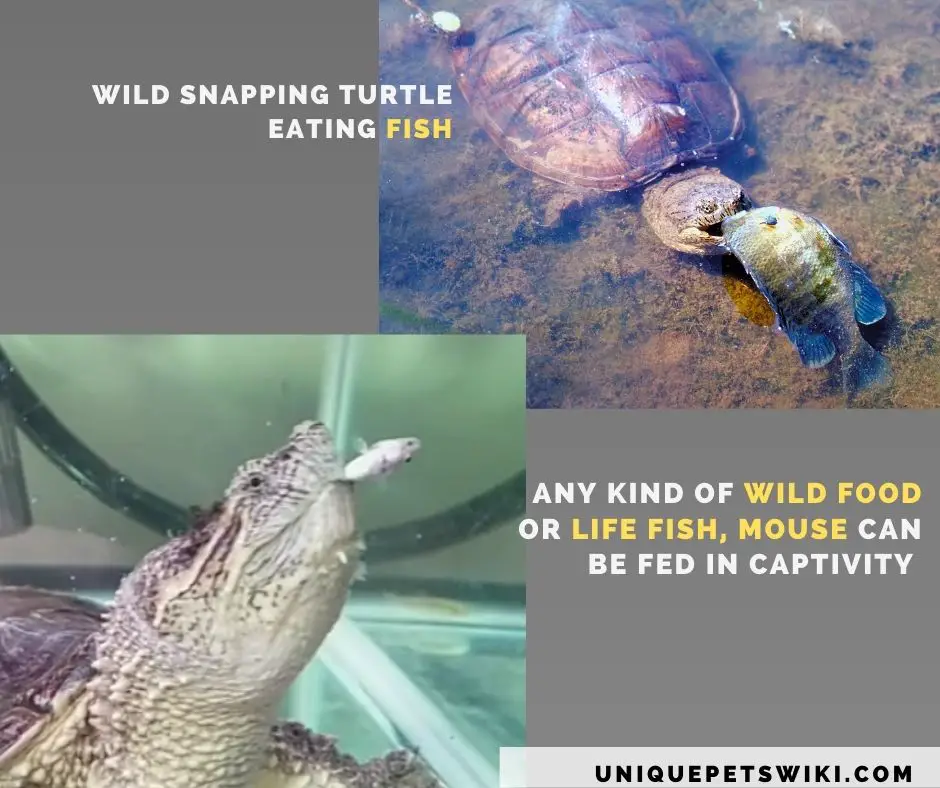
What Should You Feed Snapping Turtles In Captivity?
Depending on availability, all the food types listed above that they eat in the wild should be fed to them in captivity. Your aim as a good keeper is to feed your turtle foods that are rich in protein, calcium, vitamins, and minerals.
This will ensure that they have steady growth and a strong immune system capable of fighting diseases. When your turtle is still a juvenile (that is still growing and not yet mature) it’ll need more animal food (protein) in its diet than plants to grow.
However, when they attain maturity between 17 – 20 years, they’ll need to consume more plant matter than animal matter.
Live Fish
Snapping turtles of all ages and sizes can be fed live fish. But the size of the fish should be directly proportional to the size of the turtle.
This means that small turtles should be fed small-sized fish and vice versa. Feeding your snapping turtle live fish will encourage and sustain its hunting skill even in captivity.
Commercial Turtle Food
Commercial foods for captive snapping turtles are equally beneficial. It contains essential nutrients they need for steady and consistent shell growth. Of all the numerous brands of turtle foods you’ll see in pet stores, Fluker’s Buffet Blend is one of the best.
This brand of turtle food is rich in all the nutrients that your pet snapping turtle needs. It has high amounts of protein, calcium, vitamins, and minerals that support vibrant color, consistent shell growth, and general lively behaviors.
Fluker’s Buffet Blend was made with aquatic turtles in mind because it does not cloud or discolor the water.
Nonetheless, after each feeding when you notice that your turtle isn’t accepting the food anymore, ensure you clean out the waste food immediately.
Common Health Issues
The common health issues of captive snapping turtles is a broad topic you should read about for better understanding. Snapping turtles suffer a couple of illnesses in captivity.
All of which are related to poor husbandry which would have been prevented with proper care. These health issues not only discomfort the turtles but also shorten their lifespan.
In the absence of diseases brought about by poor husbandry, snapping turtles can thrive in captivity for over 50 years. However, once their immune system is compromised because of one or two issues in their habitat, they’re likely to get sick.
In many cases, symptoms of illnesses aren’t easily seen until it gets worse. This is why maintaining a standard husbandry at all times is vital to their health and general wellbeing.
Besides, it’s also important that you understand the meaning and causes of all ill symptoms and odd behaviors and can easily tell when something is wrong with your pet turtle.
Some of the common health issues you’re likely to encounter in captivity include:
- Metabolic bone disease (MBD)
- Vitamin A deficiency.
- Egg retention.
- Respiratory infection.
- Internal parasites.
- Ear abscesses.
- Obesity.
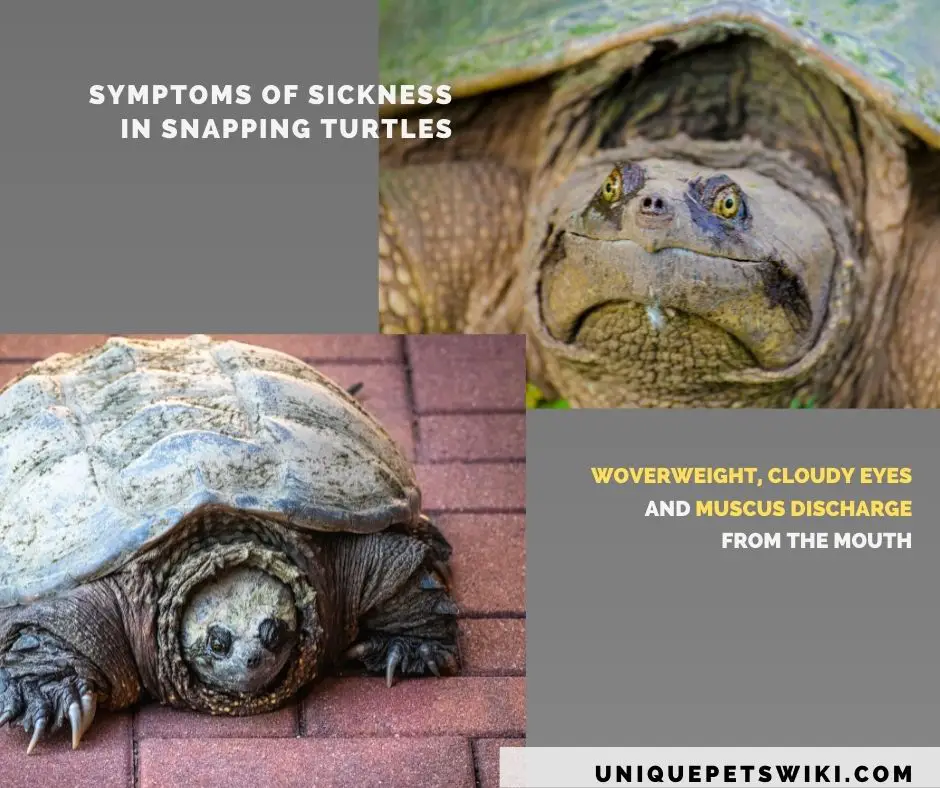
When your snapping turtle suffers from any of these diseases, you’ll know through symptoms and odd behaviors such as:
- General weakness of the bones (both hind and forelegs).
- Lethargy.
- Loss of appetite.
- Weight loss.
- Cloudy eyes.
- Smelly pus-like discharge from the ears.
- Runny and smelly poops.
- No poops (impaction).
- Pale-looking shell color.
- Gasping, and many others.
Symptoms of diseases and treatment are best done by an experienced vet. Hence, consult your vet if you suspect any sickness in your animal.
Choosing Good Snapping Turtle
Congratulations! Now that you have decided to add a snapping turtle to your collection of pets, what should you do to make sure that you’re getting a healthy pet and not a sick animal?
Relax, this section will unravel to you what you should check before paying for the animal and bringing it home.
Buying your choice pet from ‘just any pet dealer’ and realizing later that it is sick can be devastating. You don’t need to experience that. This is why it’s important you know what to look for before paying for the animal.
Nice Appearance
By nice appearance, it isn’t referring to the most beautiful animal in the pet store, but the animal that its color isn’t looking pale. Snapping turtles have black or dark brown shells with a yellow or near-white plastron.
To know that the snapping turtle is viable the colors must be vibrant and not looking dull.
No Eye Issues
Before getting your new pet, check for cloudy eyes, sunken eyes, or popped-out eyes. Any of these signs is to mean that the turtle is sick. This can be a sign of vitamin A deficiency or infection.
No Claw Issue
Also, ensure that the animal you’re getting is free from claw issues. Snapping turtles have webbed claws. Each of the web and claws must be intact for it to be healthy. Where the leg is inflamed or the claws look infected, avoid the animal.

No Skin Issues
Animals kept in a poor environment are likely to have skin problems. This, like appearance, can easily be spotted. Hence, closely examine the animal to ensure that it is free from skin infections. Also, check the ear for ear abscess.
Wrapping Up
Prior to this time, a lot of information has flooded the internet about snapping turtles. Some of which are about the fact that they’re the aggressive and easily agitated animals.
This experience without a doubt was a direct result of how the owners made these animals feel either in captivity or the wild.
However, from our discussion in this article, it’s clear that although snapping turtles can be aggressive, they aren’t aggressive for no reason. Their aggressive behavior is always a direct response to their environment.
They respond this way when they feel threatened and when they’re stressed. That said, to avoid this in your pet, you must ensure you eliminate stress factors in their habitat. If you maintain an ideal environment for them, you’ll enjoy your turtle.
